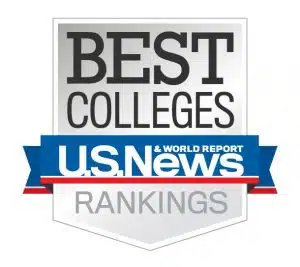Thinking about applying to Stanford? You might be wondering if you need to submit SAT or ACT scores. Here’s the deal: if you’re applying, you must take the SAT or ACT and submit your scores.
But don’t stress. We’ve got you covered! In this guide, we’ll walk you through everything you need to know, from Stanford’s testing policies to score expectations and tips to help you crush the SAT or ACT. Let’s get started!
- Stanford Standardized Testing Policy
- Stanford SAT Requirements
- Stanford ACT Requirements
- How to Ace the SAT/ACT for Stanford Admission
- Stanford Application Checklist
- Frequently Asked Questions
- Takeaways
Stanford Standardized Testing Policy
Stanford is no longer test-optional for the 2025–2026 admissions cycle and beyond. If you plan to apply, you must take the SAT or ACT and submit your scores.
Stanford takes a holistic approach to admissions, considering your grades, extracurriculars, essays, and test scores. While there’s no minimum SAT or ACT score, a strong result can give your application a competitive edge. So, if Stanford is on your college list, it’s time to start prepping!
Stanford SAT Requirements
According to Stanford’s 2023–2024 Common Data Set, here’s how admitted students typically score:
| Percentile | SAT Composite Score |
| 25th | 1500 |
| 50th | 1540 |
| 75th | 1560 |
And if we break it down by section:
| Section | 25th Percentile | 50th Percentile | 75th Percentile |
| EBRW (Reading & Writing) | 740 | 760 | 780 |
| Math | 770 | 790 | 800 |
About 96% of admitted students score between 1400 and 1600, meaning the competition is fierce. If you want to stand out, aim for a 1560+ score to put yourself in the top range.
Do you need a 1560 SAT score to get into Stanford? Not necessarily! While a high SAT score can give you an edge, Stanford looks at everything in your application. If you crush it in other areas, you don’t need a perfect SAT score, but if you can get one, why not go for it? It can only help your chances!
Stanford ACT Requirements
If you prefer the ACT over the SAT, here’s what you need to know: Stanford has no official minimum ACT score like the SAT, but higher scores make your application more competitive.
According to the same Common Data Set, here’s the ACT score breakdown:
| Percentile | ACT Composite Score |
| 25th | 34 |
| 50th | 35 |
| 75th | 35 |
Breaking it down by subject:
| Section | 25th Percentile | 50th Percentile | 75th Percentile |
| Math | 32 | 35 | 35 |
| English | 35 | 35 | 36 |
| Reading | 34 | 35 | 36 |
| Science | 33 | 35 | 36 |
Most admitted students score between 30 and 36. If you want to maximize your chances, aim for a 35 or higher on the ACT.
Remember, while a high ACT score helps, Stanford isn’t looking for test-taking machines. They want students who bring something special. Maybe you’re a star athlete, a coding whiz, or a passionate artist. That’s a plus! So, focus on being your most well-rounded and impressive version.
How to Ace the SAT/ACT for Stanford Admission
Since Stanford will require standardized test scores, you’ll need a strong test prep plan. Here’s how to boost your score:
1. Take official practice tests.
The best way to prepare for the SAT or ACT is to practice with real tests. The College Board (SAT) and ACT.org offer official practice exams that match the real thing. Taking these under timed conditions will help you get used to the pacing, question styles, and overall test structure so there are no surprises on test day.
After each practice test, take time to review your mistakes. Don’t just check the right answers. Figure out why you missed something. Did you run out of time? Did you misread the question? Forget a key concept? The more you analyze your mistakes, the better you’ll get at avoiding them.
2. Use free online resources.
You don’t have to spend money to prep! Khan Academy has an official partnership with the College Board, offering personalized SAT practice that adapts to your strengths and weaknesses.
For additional SAT practice, check out College Board’s Bluebook app. It offers full-length digital practice tests that closely match the real SAT experience. These free resources can help you sharpen your skills and build confidence before test day.
3. Focus on your weaknesses.
Everyone has that one subject that just doesn’t click. If math is a struggle, focus on algebra, geometry, and data analysis problems. If reading comprehension trips you up, practice breaking down passages and spotting key ideas. Instead of doing random practice, zero in on your weakest areas to see the biggest improvement.
One of the best ways to tackle weak spots is to set up a study plan that targets them. Keep track of the types of questions you consistently miss and spend extra time drilling those topics. Even just 15–20 minutes a day of focused practice can make a huge difference over time.
4. Train your brain with timed drills.
One of the biggest challenges of the SAT and ACT is managing your time under pressure. Each section of these tests is strictly timed. On the SAT, for example, you have about 1 minute and 10 seconds per math question, and 1 minute and 15 seconds per reading question. The ACT gives you 1 minute per math question and just 52.5 seconds per reading question.
To build speed and accuracy, practice with timed drills focused on specific question types. Set a timer for 10–15 minutes and challenge yourself to complete a set of math problems or reading passages within that limit, sticking to the official time per question.
As you become more comfortable with the pacing, gradually shorten the time or increase the difficulty. By test day, you’ll feel more confident handling the clock and avoiding last-minute panic.
5. Get a tutor for a personalized boost.
If you feel stuck and your score isn’t going up, a tutor can help you break through and get those extra points. Instead of following a one-size-fits-all study plan, a tutor focuses on your weak spots, maybe tricky algebra problems, tough reading passages, or better time management. They’ll give you tips, shortcuts, and strategies to help you improve faster.
A tutor keeps you on track and motivated so you don’t fall behind or get overwhelmed. Even a few sessions can make a huge difference in boosting your confidence and score before test day. Every point counts if you’re aiming for Stanford, so getting extra help could be the game-changer you need!
Stanford Application Checklist
Applying to Stanford? Here’s what you need to submit:
1. Submit your application.
You’ll need to apply using the Common Application, which asks for basic info about you, your academics, and your extracurriculars.
Before you hit submit, take a final look at everything. Spelling errors or missing details can make a bad impression. Since Stanford is super competitive, you want your application to be polished and reflect your best self!
2. Pay the application fee or request a waiver.
Stanford’s application fee is $90, and it’s nonrefundable. You must pay this when you submit your application. If the fee is a financial burden, don’t worry. You can request a fee waiver through the Common App. Stanford doesn’t want cost to be a barrier, so they’ll cover the fee if you qualify.
3. Send your high school transcript.
Your transcript is a key part of your application. It shows the classes you’ve taken, the grades you’ve earned, and how challenging your coursework has been. If your school automatically sends transcripts, check with your counselor to ensure yours gets sent on time.
Stanford admits have an average GPA of 3.9. Stanford looks for students who push themselves with rigorous courses like AP, IB, or honors classes.
4. Submit your letters of recommendation.
You’ll need two teacher recommendations and one from your school counselor. Choose teachers who know you well and can speak about your work ethic, curiosity, and character. Give your recommenders plenty of time to write strong letters for you. A rushed recommendation won’t be as impactful as one that’s thoughtful and detailed.
5. Write your essays.
Stanford’s essays are a huge part of your application. You’ll need to answer Stanford-specific prompts plus your Common App personal statement. These essays let you show who you are beyond grades and scores. Need help? We’ve got a guide to walk you through crafting standout responses!
6. Highlight your extracurricular activities.
Stanford wants to see what excites you outside the classroom, so don’t just list your extracurriculars. Show what you’ve accomplished in them.
Maybe you’re in FBLA and launched a community business initiative, or you’re part of Model United Nations (MUN) and won Best Delegate at a national conference. Are you in the Science Olympiad and led your team to regionals? Or maybe you’re in Speech and Debate and dominated in persuasive speaking.
Find activities that align with your passions and Stanford’s values, then highlight the leadership, achievements, and experiences that set you apart.
7. Send your SAT or ACT scores.
Stanford requires you to submit SAT or ACT scores. Most admitted students score 1500–1560 on the SAT and 34–35 on the ACT. To stay competitive, you’ll want to aim this high.
8. Schedule an interview (optional).
Stanford offers optional alumni interviews, depending on availability. If you’re invited, it’s a great chance to discuss your interests and ask questions about the school. Interviews are casual and conversational, so don’t stress! Just be yourself and share why you’re excited about Stanford.
9. Submit an art portfolio (optional).
If you’re an artist, musician, filmmaker, or performer, you can submit an art portfolio to showcase your talent. This is completely optional, but it can help strengthen your application if you’re applying to programs related to the arts. A well-organized, high-quality submission can leave a strong impression!
Frequently Asked Questions
1. Does Stanford superscore the SAT?
If you take the SAT multiple times, you’re in luck. Stanford does superscore. That means they’ll take your highest section scores from different test dates and combine them to give you the best possible total.
So, if you aced math on one test but did better in reading and writing on another, Stanford will use your best scores from each section. If you’re retaking the SAT, focus on improving one section at a time, and you could end up with a stronger superscore!
2. What SAT and ACT scores do I need for Stanford?
Stanford doesn’t have a strict cutoff, but most admitted students have top-tier scores. For the SAT, a competitive score is around 1560+ (out of 1600), and for the ACT, a 35+ (out of 36) puts you in a strong position.
However, getting in isn’t just about test scores. Stanford evaluates your entire application, including your grades, extracurriculars, and essays. If your scores are slightly lower but you shine in other areas, you still have a shot!
3. Do I need to take the SAT or ACT for Stanford now?
Yes, you do. Stanford isn’t test-optional, so you must submit SAT or ACT scores. That means no skipping the test and hoping your grades and activities will carry you. If Stanford is your dream school, start prepping now. Give yourself enough time to take the test, improve your score if needed, and submit your best possible results!
4. How should I prepare for the SAT or ACT?
Start by taking official practice tests to see where you stand and which areas need improvement. Use free resources like Khan Academy (for SAT prep) or ACT.org’s practice materials to sharpen your skills. If you struggle with time management, practice timed drills to build speed and accuracy. If you need extra help, consider working with a tutor or joining a prep course.
Takeaways
- Aim for an SAT score between 1500–1560 or an ACT score of 34–35 to stay competitive.
- A killer SAT or ACT score can boost your chances, but Stanford cares just as much about your grades, extracurriculars, and essays.
- Practicing with official SAT/ACT tests, using free resources like Khan Academy, and focusing on your weak spots can help you score top.
- Besides test scores, you’ll need solid essays, recommendation letters, and a strong extracurricular record to stand out at Stanford.
- Need help applying to Stanford? A college admissions expert can guide you through the process, from crafting standout essays to boosting your test scores!



































